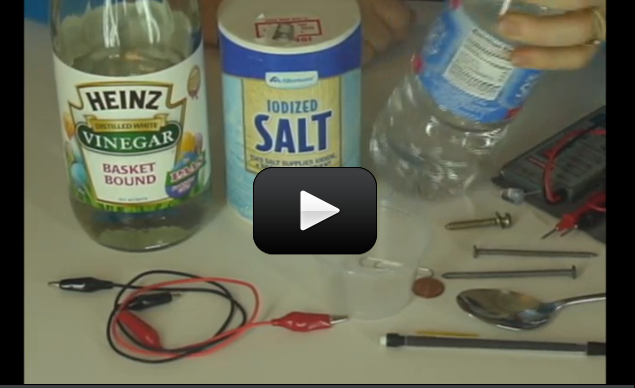Using ocean water (or make your own with salt and water), you can generate enough power to light up your LEDs, sound your buzzers, and turn a motor shaft. We’ll be testing out a number of different materials such as copper, aluminum, brass, iron, silver, zinc, and graphite to find out which works best for your solution.
This project builds on the fruit battery we made in Unit 8. This experiment is for advanced students.
The basic idea of electrochemistry is that charged atoms (ions) can be electrically directed from one place to the other. If we have a glass of water and dump in a handful of salt, the NaCl (salt) molecule dissociates into the ions Na+ and Cl-.
When we plunk in one positive electrode and one negative electrode and crank up the power, we find that opposites attract: Na+ zooms over to the negative electrode and Cl- zips over to the positive. The ions are attracted (directed) to the opposite electrode and there is current in the solution.
Please login or register to read the rest of this content.


Hi Sky,
Thanks for writing! Sometimes if an answer doesn’t show up to a question, it’s because I either called them personally or wrote a private email. I should really specify that so it doesn’t look like people are left hanging with their questions.
As for your particular question, I recommend families who teach by grade level go back to the topics to pick up the reading there. Also, the background reading and detailed explanations are included in the worksheet that accompany many of the experiment lessons. But for the actual textbook reading, you’ll need to go back to the topic itself. We find that learning is not segmented depending on age/grade, but rather dependent on a child’s experience and interest, as well as the parent’s educational goals for their child.
However, many of our families need a more segmented approach to fulfill state or school district requirements, or simply prefer it. This is why eScience is designed to support a less segmented style (by topic) and a more segmented style (by grade). To learn more about how each option works, you can watch our videos on the Getting Started page here:
https://www.sciencelearningspace2.com/getting-started/
Let me know if you need additional help!
I have the same question as Aileen Chase above, which was never answered. I would like to follow the grade level recommendations, but the topic units seems to be easier to follow, however may go in a little too deep for the grade level we are at. Trying to find the best way possible to navigate and use this site. In the grade level it lists the science topics covered but there are no reading or exercise lessons and the videos seem to be for all grade levels on that topic. Help!
I’ll have my team get in touch via email!
can i have acces to salty battery
I’ll have my team connect with you!
Do we have access to the salty battery experiment? Can we?
I’ll have my team connect with you right away!
Please can I have access to salty battery
I’ll have my team connect with you right away!
can I please have access to the salty battery experiment!!!
I’ll have my team connect with you right away.
Could you give me access to the salty battery experiment please?
Thanks!
Heather
It’s something that conducts electricity, that is used to make contact in a circuit. A battery has two electrodes (plus and minus). You can read more about how it was discovered and named here.
what are electrodes
I’ll have my team connect with you right away!
I’m really new to this program and trying to understand how to navigate it. I clicked on the 4th grade level button and this experiment was listed, but says its for grades 9-12 and I don’t have access to it. I thought all of the experiments listed under each grade level were appropriate for that level.
When you say “ruined”, what happened exactly? And did you substitute anything for this experiment? Sometimes if the salt has other trace minerals it can sometimes leave the color a bit off. And yes, as a good reminder to everyone: don’t use nice stuff for science experiments in general because you never know what can happen!
I don’t recommend using silver spoon – it ruin mine
if you put more in will it generate more